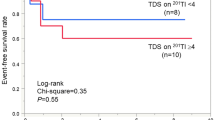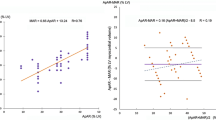Abstract
123I-BMIPP [15-(p-iodophenyl)-3-(R,S)-methylpentadecanoic acid] was developed for metabolic imaging with SPECT. A multicenter collaborative study was conducted on a large patient series to determine whether123I-BMIPP and201Tl myocardial SPECT are of use in predicting the prognosis and ventricular function after acute myocardial infarction (AMI). Patients with uncomplicated first AMI underwent resting123I-BMIPP and201Tl myocardial SPECT in the subacute phase after the onset of AMI. Of these, 167 patients who had been followed up for an average of 22 months were retrospectively reviewed to predict serious cardiac events and recurrent ischemia. In addition, the association between changes in radionuclide parameters and recurrent ischemia was investigated in Subgroup A (58 patients) who had repeated SPECT in the chronic phase. Furthermore, prediction of the ejection fraction (EF) was investigated in Subgroup B (94 patients) and Subgroup C (76 patients) in whom left ventriculography was performed at the time of discharge and 90 days or more after the onset, respectively. The prognosis was generally favorable, with 4 cases of cardiac death (2%), 3 of heart failure (2%), 4 of nonfatal reMI (2%), and 25 of recurrent ischemia (15%). The results of Cox multivariate regression analysis revealed a high probability of serious cardiac events in patients who were elderly (p = 0.04), who had 90% or more residual stenosis of the infarct-related artery (p = 0.09), and who had a high BMIPP defect score (p = 0.17). There was a high probability of recurrent ischemia in elderly patients (p = 0.10) who had multi-vessel disease (p = 0.03), but no association was found with radionuclide parameters in the subacute phase. In Subgroup A, however, the probability of recurrent ischemia tended to be high in patients with a large mismatch score between123I-BMIPP and201Tl in the subacute to chronic phase. An important observation was that the extent of BMIPP defect was more strongly correlated with EF at the time of discharge and 90 days or more after the onset than the extent of Tl defect (r = −0.60 vs. r = −0.47, and r = −0.53 vs. r = −0.43, respectively). In addition, multiple regression analysis showed that parameters related to the BMIPP defect were also better predictive factors of EF both at the time of discharge and 90 days or more after the onset. In conclusion, resting123I-BMIPP and201Tl myocardial SPECT performed in the subacute phase of AMI were shown to be useful in predicting prognosis and ventricular function for patient management.
Similar content being viewed by others
References
Brown KA. Prognostic value of thallium-201 myocardial perfusion imaging: a diagnostic tool comes of age.Circulation 83: 363–381, 1991.
Gibson RS, Watson DD, Graddock GB, Crampton RS, Kaiser DL, Denny MJ, et al. Prediction of cardiac events after uncomplicated myocardial infarction: a prospective study comparing predischarge exercise thallium-201 scintigraphy and coronary angiography.Circulation 68: 321–336, 1983.
Brown KA, O’Meara J, Chambers CE, Plante DA. Ability of dipyridamole-thallium-201 imaging 1 to 4 days after acute myocardial infarction to predict in-hospital and late recurrent myocardial ischemic events.Am J Cardiol 65: 160–167, 1990.
Brown KA, Weiss RM, Clements JP, Wackers FJ Th. Usefulness of residual ischemic myocardium within prior infarct zone for identifying patients at high risk late after acute myocardial infarction.Am J Cardiol 60: 15–19, 1987.
The Multicenter Post Infarction Research Group. Risk stratification and survival after myocardial infarction.N Engl J Med 309: 331–336, 1983.
Cerqueira MD, Maynard C, Ritchie JL, Davis KB, Kennedy JW. Long-term survival in 618 patients from the Western Washington streptokinase in myocardial infarction trials.J Am Coll Cardiol 20: 1452–1459, 1992.
Simoons ML, Vos J, Tijssen JGP, Vermeer F, Verheugt FWA, Krauss XH, et al. Long-term benefit of early thrombolytic therapy in patients with acute myocardial infarction: 5 year follow-up of a trial conducted by the interuniversity cardiology institute of the Netherlands.J Am Coll Cardiol 14: 1609–1615, 1989.
Zaret BL, Wackers FJ Th, Terrin ML, Forman SA, Williams DO, Knatterud GL, et al. Value of radionuclide rest and exercise left ventricular ejection fraction in assessing survival of patients after thrombolytic therapy for acute myocardial infarction: results of thrombolysis in myocardial infarction (TIMI) Phase II study.J Am Coll Cardiol 26: 73–79, 1995.
Sobel BE. Coronary thrombolysis and the new biology.J Am Coll Cardiol 14: 850–860, 1989.
Moss AJ, Goldstein RE, Hall WJ, Bigger JT, Fleiss JL, Greenberg H, et al. Detection and significance of myocardial ischemia in stable patients after recovery from an acute coronary event. Multicenter myocardial ischemia research group.JAMA 269: 2379–2385, 1993.
Miller TD, Gersh BJ, Christian TF, Bailey KR, Gibbons RJ. Limited prognostic value of thallium-201 exercise treadmill testing early after myocardial infarction in patients treated with thrombolysis.Am Heart J 130: 259–266, 1995.
Dakik HA, Mahmarian JJ, Kimball KT, Koutelou MG, Medrano R, Verani MS. Prognostic value of exercise201Tl tomography in patients treated with thrombolytic therapy during acute myocardial infarction.Circulation 94: 2735–2742, 1996.
Eitzman D, Al-Aouar Z, Kanter HL, vom Dahl J, Kirsh M, Deeb GM, et al. Clinical outcome of patients with advanced coronary artery disease after viability studies with positron emission tomography.J Am Coll Cardiol 20: 559–565, 1992.
Tamaki N, Kawamoto M, Takahashi N, Yonekura Y, Magata Y, Nohara R, et al. Prognostic value of an increase in fluorine-18 deoxyglucose uptake in patients with myocardial infarction: Comparison with stress thallium imaging.J Am Coll Cardiol 22: 1621–1627, 1993.
Di Carli MF, Davidson M, Little R, Khanna S, Mody FV, Brunken RC, et al. Value of metabolic imaging with positron emission tomography for evaluating prognosis in patients with coronary artery disease and left ventricular dysfunction.Am J Cardiol 73: 527–533, 1994.
Knapp FF Jr, Kropp J. Iodine-123-labelled fatty acids for myocardial single photon emission tomography: current status and future perspective.Eur J Nucl Med 22: 361–381, 1995.
Yamamichi Y, Kusuoka H, Morishita K, Shirakami Y, Kurami M, Okano K, et al. Metabolism of iodine-123-BMIPP in perfused rat hearts.J Nucl Med 36: 1043–1050, 1995.
Nishimura T. Current status of nuclear cardiology in Japan.J Nucl Cardiol 3: 422–427, 1996.
Hashimoto A, Nakata T, Tsuchihashi K, Tanaka S, Fujimori K, Iimura O. Post ischemic functional recovery and BMIPP uptake after primary percutaneous transluminal coronary angioplasty in acute myocardial infarction.Am J Cardiol 77: 25–30, 1996.
Ito T, Tanouchi J, Kato J, Morioka T, Nishino M, Iwai K, et al. Recovery of impaired left ventricular function in patients with acute myocardial infarction is predicted by the discordance in defect size on123I-BMIPP and201Tl SPET images.Eur J Nucl Med 23: 917–923, 1996.
Nishimura T, Uehara T, Shimonagata T, Nagata S, Haze K. Clinical results with β-methyl-p-(123I) iodophenyl pentadecanoic acid, single photon emission computed tomography in cardiac disease.J Nucl Cardiol 1: S65-S71, 1994.
Tamaki N, Kawamoto M. The use of iodinated free fatty acids for assessing fatty acid metabolism.J Nucl Cardiol 1: S72-S78, 1994.
Subcommittee for standardization of radionuclide imaging, medical and pharmaceutical committee, Japan Radioisotope Association. Standard of nuclear medicine protocols (The 3rd revision, 1994).Radioisotopes 43: 81–114, 1994.
Rentrop KP, Cohen M, Blanke H, Phillips RA. Changes in collateral channel filling immediately after controlled coronary artery occlusion by an angioplasty balloon in human subjects.J Am Coll Cardiol 5: 587–592, 1985.
Cox DR. Regression models and life-tables (with discussion).J Royal Stat Soc Series B 34: 187–220, 1972.
Cary, North Carolina: SAS Institute Inc.SAS Technical Report P-229, SAS/STAT software: Changes and Enhancement, release 6.07 edition, 620 p, 1992.
Cary, North Carolina: SAS Institute Inc.SAS/STAT User’s Guide, release 6.03 edition, 1028 p, 1988.
The TIMI study group. The thrombolysis in myocardial infarction (TIMI) trial. Phase I findings.N Engl J Med 312: 932–936, 1985.
Fujibayashi Y, Yonekura Y, Takemura Y, Wada K, Matsumoto K, Tamaki N, et al. Myocardial accumulation of iodinated beta-methyl-branched fatty acid analogue, iodine-125-15-(p-iodophenyl)-3-(R,S)methylpentadecanoic acid (BMIPP), in relation to ATP concentration.J Nucl Med 31: 1818–1822, 1990.
Ogata M, Kajiyama K, Yamaguchi Y, Koga Y, Toshima H. BMIPP uptake in adriamycin cardiomyopathic rat hearts.J Mol Cell Cardiol 20: 28–32, 1988.
Tamaki N, Kawamoto M, Yonekura Y, Fujibayashi Y, Takahashi N, Konishi J, et al. Regional metabolic abnormality in relation to perfusion and wall motion in patients with myocardial infarction: assessment with emission tomography using an iodinated branched fatty acid analog.J Nucl Med 33: 659–667, 1992.
De Geeter F, Franken PR, Knapp FF Jr, Bossuyt A. Relationship between blood flow and fatty acid metabolism in subacute myocardial infarction: a study by means of99mTcsestamibi and123I-β-methyl-iodo-phenyl pentadecanoic acid.EurJ Nucl Med 21: 283–291, 1994.
Franken PR, De Geeter F, Dendale P, Demoor D, Block P, Bossuyt A. Abnormal free fatty acid uptake in subacute myocardial infarction after coronary thrombolysis: correlation with wall motion and inotropic reserve.J Nucl Med 35: 1758–1765, 1994.
Tamaki N, Tadamura E, Kudoh T, Hattori N, Yonekura Y, Nohara R, et al. Prognostic value of iodine-123 labelled BMIPP fatty acid analogue imaging in patients with myocardial infarction.Eur J Nucl Med 23: 272–279, 1996.
Moss AJ, Benhorin J. Prognosis and management after a first myocardial infarction.N Engl J Med 307: 743–753, 1990.
Ito H, Tomooka T, Sakai N, Higashino Y, Fujii K, Katoh O, et al. Time course of functional improvement in stunned myocardium in risk area in patients with reperfused anterior infarction.Circulation 87: 355–362, 1993.
Picard MH, Wilkins GT, Ray P, Weyman AE. Long-term effects of acute thrombolystic therapy on ventricular size and function.Am Heart J 126: 1–10, 1993.
Bolli R. Myocardial ’stunning’ in man.Circulation 86: 1671–1691, 1992.
Pfisterer M, Zuber M, Wenzel R, Burkart F. Prolonged myocardial stunning after thrombolysis: can left ventricular function be assessed definitely at hospital discharge?Eur Heart J 12: 214–217, 1991.
Schwaiger M, Bunken R, Grover-McKay M, Krivokapich J, Child J, Tillisch JH, et al. Regional myocardial metabolism in patients with acute myocardial infarction assessed by positron emission tomography.J Am Coll Cardiol 8: 800–808, 1986.
Franken PR, Dendale P, De Greeter F, Demoor D, Bossuyt A, Block P. Prediction of functional outcome after myocardial infarction using BMIPP and sestamibi scintigraphy.J Nucl Med 37: 718–722, 1996.
Author information
Authors and Affiliations
Corresponding author
Rights and permissions
About this article
Cite this article
Nishimura, T., Nishimura, S., Kajiya, T. et al. Prediction of functional recovery and prognosis in patients with acute myocardial infarction by123I-BMIPP and201Tl myocardial single photon emission computed tomography: A multicenter trial. Ann Nucl Med 12, 237–248 (1998). https://doi.org/10.1007/BF03164908
Received:
Accepted:
Issue Date:
DOI: https://doi.org/10.1007/BF03164908




